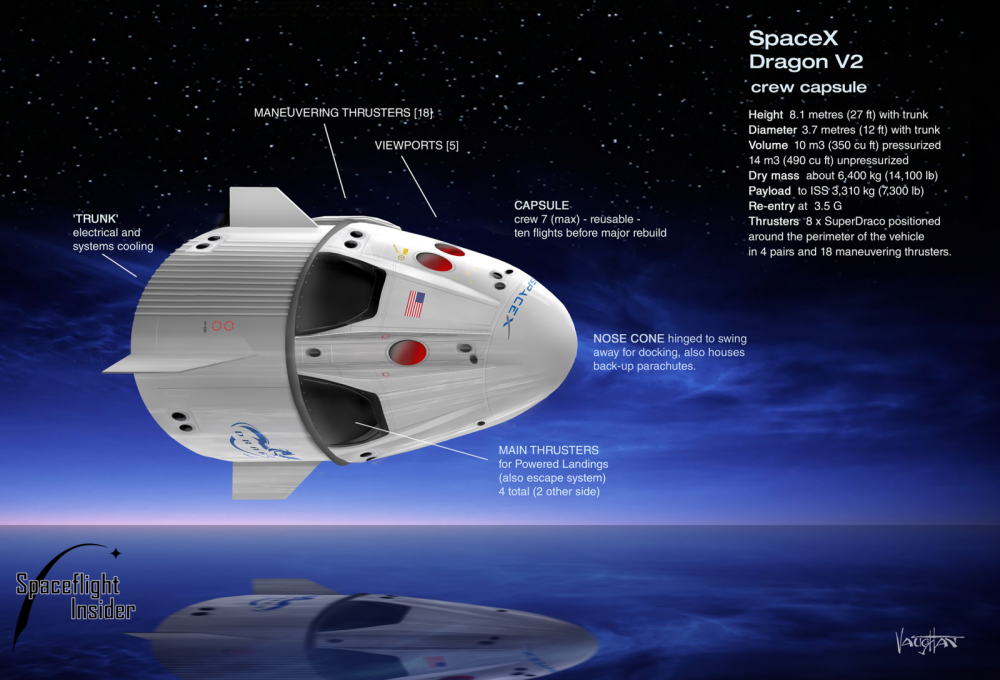We are being lied-to on a massive scale


SpaceX, the rocket company headed by Elon Musk is about to launch space tourists on a trip around the Moon, despite dire warnings since the 1950’s of “deadly” Van Allen radiation belts. Do travel companies, however exotic, send their customers on potential suicide missions? Maybe the explanation is that the science of Van Allen and countless other scientists over the past 60 years is baloney. Why, after all this time do NASA engineers tell us that they don’t have a clue what level of radiation they are likely to encounter?

History
Van Allen said “All manned space flight attempts must steer clear of these two belts of radiation until adequate means of safeguarding the astronauts has been developed”. Moreover, Van Allen advised they would have to be shielded with some extra layers of protection beyond that of the spacecraft itself. These findings were also published in Scientific American Magazine, March, 1959. Two years later, Van Allen updated his report in Space World Magazine, December, 1961. In brief, he reported that everything he had found in 1959 was still valid. It was also in that year that President John F. Kennedy told an assembled group of students and dignitaries at Rice University in Houston, that it was America’s destiny to put a man on the moon by the end of the decade. Article in Media Bypass Magazine,Sept.1997
https://archive.org/details/MediaBypassSept1995Vol3No9
Ignoring the warning, in December of 1968 Apollo 8 was launched and crossed the Van Allen belts the crew being the first humans to see the far side of the Moon. The final manned lunar mission, Apollo 17 was launched on 7 December 1972 and no human has been above low Earth orbit since that date…until now:
Let’s go to the Moon again
nytimes.com: SpaceX, the ambitious rocket company headed by Elon Musk, wants to send a couple of tourists around the moon and back to Earth before the end of next year. If they manage that feat, the passengers would be the first humans to venture that far into space in more than 40 years. Below is a confusing and contradictory video narrated by a NASA engineer who tells us that they just don’t know what to expect when they fly their *unmanned for safety* Mars craft through the belts. What became of the 60+ years of science? Can it be that after the problems encountered in landing Apollo 11 and all the gravity problems encountered by the preceding probes, NASA has given up on NASA science and the engineers have decided to do the job themselves?
(VIDEO) NASA’s Orion Engineer Admits They Can’t Get Past Van Allen Radiation Belts See also the page Moon: Gravitational Anomalies: where we take a look at some other science induced problems.
NASA Orion Manned Mars Mission
21stcenturywire.com says: In the video presentation below, NASA engineer Kelly Smith explains about many of the risks and pitfalls surrounding the new Orion Deep Space Mission to the planet Mars.
Surprisingly, chief among Kelly’s concerns is whether or not his spacecraft can successfully pass through the perilous Van Allen Radiation Belts. Such is the prospective danger in fact, that NASA will have to send a dumbie (dummy?) craft first in order to ‘test out’ what the potential radiation effects will be on future human crews, as well as on the ship’s delicate sensors and equipment.
(VIDEO) NASA’s Orion Engineer Admits They Can’t Get Past Van Allen Radiation Belts
Why is SpaceX Elon Musk making promises before these tests are carried-out?
There’s a discussion here that says it’s the electronics only that need protection. So why cannot they calculate it from the NASA math below? Are there no scientists and mathematicians on the manned Mars project?
But the Chinese have already answered the question for them?

Bristling with microelectronics the Chinese Lunar Exploration Program soft landed a rover and other equipment in 2013, apparently without damage.
Chang’e 3, launched on 2 December 2013 aboard a Long March 3B rocket, landed on the Moon on 14 December 2013. It carried with it a 140 kg (310 lb) lunar rover named Yutu, which was designed to explore an area of 3 square kilometres (1.2 sq mi) during a 3-month mission. It was also supposed to conduct ultra-violet observations of galaxies, active galactic nuclei, variable stars, binaries, novae, quasars, and blazars, as well as the structure and dynamics of the Earth’s plasmasphere.
Chang’e 4, originally scheduled for 2015, was a back-up for Chang’e 3. However, as a result of the success of that mission, the configuration of Chang’e 4 was adjusted to test equipment in advance of the next mission.[9]
https://en.wikipedia.org/wiki/Chinese_Lunar_Exploration_Program#Phase_II:_Soft_landers.2Frovers

NASA Math!
spacemath.gsfc.nasa.gov: 4. Some people believe that the Apollo moon landings were a hoax because astronauts would have been instantly killed in the radiation belts. According to the US Occupation Safety and Health Agency (OSHA) a lethal radiation dosage is 300 Rads in one hour. What is your answer to the ‘moon landing hoax’ believers?
(I must admit that I was a doubter after reading Van Allen, but here we have NASA telling us there is not a problem at all)
Note: According to radiation dosimeters carried by Apollo astronauts, their total dosage for the entire trip to the moon and return was not more than 2 Rads over 6 days. The total dosage for the trip is only 11.4 Rads in 52.8 minutes. Because 52.8 minutes is equal to 0.88 hours, his is equal to a dosage of 11.4 Rads / 0.88 hours = 13 Rads in one hour, which is well below the 300 Rads in one hour that is considered to be lethal.
Also, this radiation exposure would be for an astronaut outside the spacecraft during the transit through the belts. The radiation shielding inside the spacecraft cuts down the 13 Rads/hour exposure so that it is completely harmless
Questions arise with the above as to where (if they ever did) did they get their data regarding the benign radiation? If it exists, it has not been made public and even NASA engineers don’t know about it. Additionally: everything I’ve read on the subject of Apollo shielding says it did not exist.
Wiki says: September 26, 1957: Thirty-six Rockoons (balloon-launched rockets) were launched from Navy icebreaker U.S.S. Glacier in Atlantic, Pacific, and Antarctic areas ranging from 75° N. to 72° S. latitude, as part of the U.S. International Geophysical Year scientific program headed by James A. Van Allen and Lawrence J. Cahill of The University of Iowa. These were the first known upper atmosphere rocket soundings in the Antarctic area. Launched from IGY Rockoon Launch Site 2, Atlantic Ocean; Latitude: 0.83° N, Longitude: 0.99° W.
https://en.wikipedia.org/wiki/James_Van_Allen#International_Geophysical_Year
The Geiger counter carried on these missions and in its present form has been with us since 1928, so what is the problem? Why does NASA need to do the measurements again?

Professor Van Allen’s 2004 response to Jay Windley and Lambert’s enquiry
Dear Mr. Lambert,
In reply to your e-mail, I send you the following copy of a response that I wrote to another inquiry about 2 months ago —
Ø The radiation belts of the Earth do, indeed, pose important constraints on the safety of human space flight.
Ø The very energetic (tens to hundreds of MeV) protons in the inner radiation belt are the most dangerous and most difficult to shield against. Specifically, prolonged flights (i.e., ones of many months’ duration) of humans or other animals in orbits about the Earth must be conducted at altitudes less than about 250 miles in order to avoid significant radiation exposure.
Ø A person in the cabin of a space shuttle in a circular equatorial orbit in the most intense region of the inner radiation belt, at an altitude of about 1000 miles, would be subjected to a fatal dosage of radiation in about one week.
Ø However, the outbound and inbound trajectories of the Apollo spacecraft cut through the outer portions of the inner belt and because of their high speed spent only about 15 minutes in traversing the region and less than 2 hours in traversing the much less penetrating radiation in the outer radiation belt. The resulting radiation exposure for the round trip was less than 1% of a fatal dosage – a very minor risk among the far greater other risks of such flights. I made such estimates in the early 1960s and so informed NASA engineers who were planning the Apollo flights. These estimates are still reliable.
Ø The recent Fox TV show, which I saw, is an ingenious and entertaining assemblage of nonsense. The claim that radiation exposure during the Apollo missions would have been fatal to the astronauts is only one example of such nonsense.
James A. Van Allen
http://www.moontruth.org/VanAllen/letters/index.htm
(James Van Allen denying the very radiation dangers he built his career upon.)
NASA Scientists and Engineers Evaluate Orion Radiation Protection Plan: Is this some kind of joke?!!

Orion will be equipped with a radiation-sensing instrument integrated into the vehicle called the Hybrid Electronic Radiation Assessor, or HERA, to provide a warning if crew members need to take shelter in the case of a radiation event, such as a solar flare. To protect themselves, astronauts will position themselves in the central part of the crew module largely reserved for storing items they’ll need during flight and create a shelter using the stowage bags on board. The method protects the crew by increasing mass directly surrounding them, and therefore making a denser environment that solar particles would have to travel through, while not adding mass to the crew module itself.
Read it and weep at: https://www.nasa.gov/feature/scientists-and-engineers-evaluate-orion-radiation-protection-plan
The Engineer
Scientist’s look upon engineers as being underlings, tinkerers and they want no part or responsibility for their work. However, having given the engineers no information, if the craft fries in the Van Allen they will say “Van Allen told you so”. If the flight is successful they will say “it’s all down to NASA math” (above) and ‘we knew what would happen all along’. Science has to maintain the illusion that it knows it all. Scientists will avoid giving information to engineers because that means responsibility and responsibility means they will get the blame if anything goes wrong. They will be expected to put it right and they like that job to stay with the engineers. This is how science works.
The Answer
Science has become politics, the danger from Van Allen’s radiation was a NASA cold war scam and Van Allen was a NASA patsy.
“In the May 4, 1959 issue of Time magazine, its writers credited James Van Allen as the man most responsible for giving the U.S. “a big lead in scientific achievement.” They called Van Allen “a key figure in the cold war’s competition for prestige. …. Today he can tip back his head and look at the sky. Beyond its outermost blue are the world-encompassing belts of fierce radiation that bear his name. No human name has ever been given to a more majestic feature of the planet Earth.”” https://en.wikipedia.org/wiki/James_Van_Allen
Challenging dominant physics paradigms by Juan Miguel Campanario and Brian Martin: “The usual image of the scientist is of a cool, calm, detached, objective observer, but the reality is quite different (Mahoney 1976; Mitroff 1974), as anyone who knows scientists is aware. The classic study of the psychology of scientists is Ian Mitroff’s book The Subjective Side of Science, in which he revealed that Apollo moon scientists were strikingly committed to their ideas, so much so that contrary evidence seemed to have little influence on their views. As well, scientists express strong views, often quite derogatory, about other scientists. To expect every scientist to react coolly and objectively to a competitor’s idea is wishful thinking, though there are some scientists who approach the ideal. Intriguingly, Mitroff found that it was often the top scientists who were the most strongly committed to their ideas.”
See also: Moon gravitational anomalies for scientist’s intransigent mind-set.
